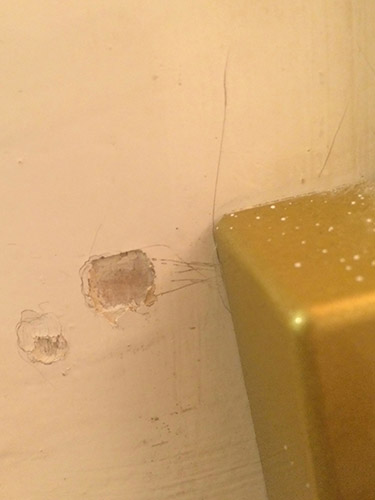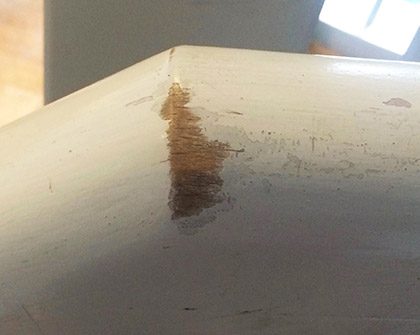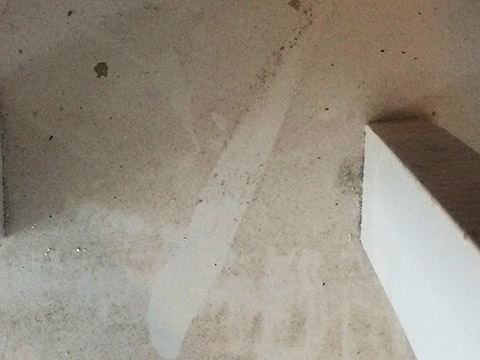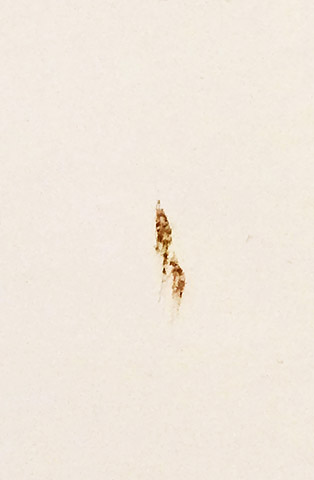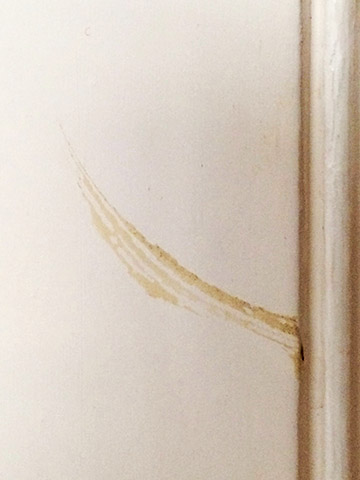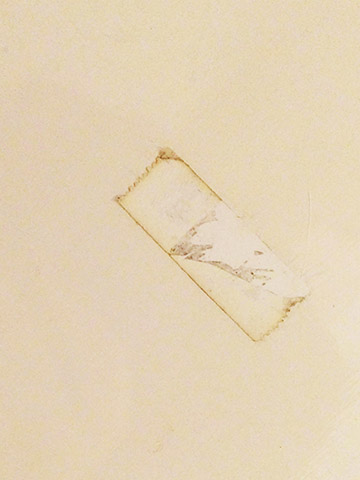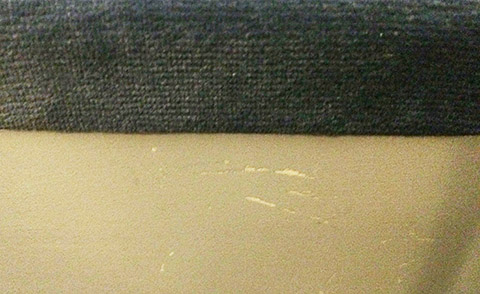He was looking for evidence. Or he was looking to give substance to what he felt she was feeling. Love doesn’t, out of nowhere, fade away, he thought; its fading means that something’s become not as it seemed.
He would inspect their home for unfamiliar traces: glove prints, hairs, dust, lipstick smudges, plant fibers, mineral or synthetic fibers, shards of glass, paint chips, soil, footprints, skid marks, filmy residues. From experience he knew that when ladder feet slide they leave lines on the ground to show how the accident happened. He was sure she had been lying to him, and that some mark would give her away—a bite mark, a puncture wound, a hole torn out, a hole worn in, or similar stigmata.
She was spending more time on her computer, she had started smoking again, the dust in the corner had begun to build up: a pile of ash and skin.
Skin, she found, was enough to give the illusion away. It shouldn’t be transparent, but should show red when held up to a bulb. She held her hand up to the window, and even by the streetlamp light, it was true, the skin pulled across her flesh and bones seemed to glow. The glow gave an impression of the variegated material inside; of vital subcutaneous activity involving differentiated flesh, veins and arteries; of pockets of waste, oxygen, lymph; of fat; of organs wedged between ribs and muscles. The skin holds the image together: as if this flesh were hanging off bones, as if there were skeletal structure inside.
He would pantomime his love, pointing at his mug. “This face? Never lies.” Then at his chest, his groin. “This heart? This body? Never lies.” In a few simple movements he showed so much: his feelings, as well as a deeply held belief in the capacity of material to speak. As he saw it, a body bears its path through time in all manner of marks, scars, pocks, pits, burns, bruises. Time and experience work away at a thing, and it gradually gives itself away; through the way it falls apart, the parts of it that degrade, the noise it makes when struck. Possible paths toward death include gradual dissolving, burning up, crumbling, or being bored into.
There’s narrative specificity to decay, he thought. For example: the perpetual bald patch on the front of each shin where his hair had rubbed off against the heavy navy folds of his work pants. His whole life, it seemed, he had worked on ladders. He stood on his tiptoes, he built his calf muscles, and as his calves expanded his shins rubbed ever more tenderly up against the rungs and hugging pants. His work showed in the hairless patches.
Was the surface worn away by mold, fungus, oxidation, or rust? The material truth of the missing front.
He learns about the thing by watching how it dies.
She wonders, What is learned if the thing never dies?
He stood at the top of the ladder and adjusted the lighting on the museum’s sculpture hall. He thought of the year 1491—and agony. The sixteen-year-old sculptor spent nights cutting up dead bodies in secret. The sculptor wanted to feel textures and densities of matter below the skin, how the sinews pull back and forth, how pockets of gas and waste bulge. He wanted his human forms (Jesus, Mary, David) to look real, so that they might be pitiable.
Carrara marble has been prized for its use in sculptures since classical times. This preference has to do with its isotropy, its homogeneity, and a relative resistance to shattering. Preference over the cheaper and less translucent limestone is also based on the fineness of marble’s grain, since, like resolution, grain is a measure of realism. The low index of refraction of calcite allows light to penetrate several millimeters into the stone before scattering outward, resulting in the characteristic waxy look that gives life to marble sculptures. The marble without veins or stains has always been worth more. But what of the ancients’ painted marbles? Black pupils rimmed in azure, swimming in too-white orbs, embedded in this abysmal pink. Purity of material for what, if its purity will be masked with uncanny pigments?
A section of wall near the ceiling was worn away, as if the trapdoor to their attic had been allowed to swing down hard, repeatedly, and that over time this impact had dislodged bits of plaster. These marks suggest not only that she had been up to the attic, but that she had been up to the attic over and over, to take down and put back the wrought-iron deck chairs and table set. He would never know that she threw them away and bought identical new ones each year. All she had to do was bang up the wall a little bit, since damage and stains give any wall the appearance of having a past.
The pair of warriors wear naturally irregular lashes of bronze foil; their lips, half-closed, are of copper; each row of teeth is made of a single sheet of silver; their corneas are of calcite, now yellowed; their pupils are of pasta vitrea.
Your whole life shows in your face, and you should be proud of that, her mother, or a friend of her mother’s, had told her once. The point was to continue to be happy in one’s body as it changed, not to fear getting old. Instead of fearing time, her fear became how, if what that woman said was true, to ever have an interior life. Her body would always betray whatever part of her whole life she wanted only for herself.
Red ocher shows up in the earth just the way a wrinkle shows up in the face of a man or woman. He picked out the wrinkle of this color with a penknife, mixed it for his brush, and thought that there never was a better color for flesh, for draperies, for painted mountains, for buildings and horses, for many purposes, but especially for blood.
She had lost her taste for abstraction, irony, metaphor. When you get used to dealing in simulation, the appearance of truth seems the only goal. Shaking, brushing, vacuuming, swabbing, picking over, in order to overcome this distance between them. They tried therapy.
“I feel irritated,” she said, “by how loose you are with language.”
“What?”
“You’ll say: ‘That film touched me’ or ‘I was touched by that film.’ No, it didn’t; no, you weren’t.”
Five beats of silence and averted gaze.
In one brusque motion, as if, during this silence, he’d been working up the courage to let everyone know he’d come to the end of his rope, he lifted his palms off his knees and raised his shoulders. “She has a problem with empathy, OK?” he told the therapist, who was nodding emphatically, conspiratorially, even though she was sitting right there.
Both men expected her to show what was inside on the outside. She couldn’t tell them, because they wouldn’t understand, that for her every smile was a clenched-up moment of surrender to the facial form expected of her sex. She showed resistance by letting her face go limp.
Flat affect, the therapist called it. Her affect was too smooth and even, without marked lumps or indentations; too calm, too much without waves; blunted; it had a broad, level surface, and little height or depth; it was shallow, dull, lacking, lifeless.
“Go on.”
He described an evening, which for him had marked a dark turning point in their relationship. “Scarring,” he called it. “It was the first time she met my mother. I invited her over to my childhood home. My mother made a nice dinner, roast chicken, green beans, potatoes with thyme—”
“You know how much I hate thyme.” He shook his head and waved his arms as if she were a swarm of flies.
“—and bought a new set of crystal glasses with gold rims, you know, so she would think we were high class. My mother asked her all kinds of questions about her work, took her really seriously. But she,” he pointed his thumb at her over his shoulder, “she didn’t smile once, just sat there nodding. My mother spent the week in tears.” At that point in the session she chose not to disclose that the previous mother she had met had criticized her for smiling too much. “It seems fake, I can’t believe she’s that nice,” the previous mother had said.
The therapist muttered, eyes cast down on his notebook, but the odd word came out clear: “distance,” “repulsion,” “cruelty,” “attraction.” He looked up, pleased: “Don’t we often have the most trouble empathizing with those who are most like us? So often, this aversion—I might even call it violence—is not about the great differences, but about the infinitesimal.”
They then played a game where the couple sat back to back and drew from memory, each to the best of his or her ability, the face of the other partner—a point would be proved when each person’s drawing turned out to be something like a self-portrait.
You wouldn’t believe what can build up, what kind of crud, in the space between stove and countertop. The issue of the feminine touch came between them, that is, the impression of no one having touched the surface at all. It was a problem if a counter wore on its filmy surface the broad circular strokes of an arm’s wiping. Don’t show your strokes; make it seem like the house has arranged itself. As if the silver spoons, napkins, screwdrivers, wine glasses, and teapots have come to life and polished, folded, and fixed one another, like dancing, while smiling. When that kind of work is done as it’s meant to be done, it erases itself; and it looks like no hands or arms, no strength or skill, were involved.
What is this attraction to (which is different from a valuing of) labor that conceals itself, furtive labor that builds in the place of human work a fantasy of the agency of objects? “I go into the studio and the bust makes itself.” “I go into the home and the home cleans itself.”
To the contrary—it is because objects are helpless that she feels sorry for the dripping bathroom faucet, or for the lamp she put out on the rainy curb, or for the piece of wall she’s banged up. She felt responsible for the condition of her things, for treating them nicely; as if they stared at her and said, “But I thought you brought me home because you cared.”
From the height of the ladder he worried about the irreparable damage made by barely visible forms of life. One challenge of Carrara marble is its predisposition to host black yeast, which grows in crevices, multiplies, and promotes decay. Humans are great carriers of spores, on their shoes, in their breath; viewers of art helplessly bear the invisible beings that destroy art.
“Damn it,” he said, imagining all that would be lost.
In 2008, a black spot was discovered on the outer edge of the left arm, just below the shoulder, of the copy of the David that sits outside the Palazzo Vecchio. The organism that had begun to proliferate on David’s arm resembled another biological growth, which had been found on a marble block on the outskirts of Florence. The black intergranular patina covered the block completely a few years after it was placed out of doors.
Once an unexplained fungus grew to such proportions on her left eyelid that she couldn’t open the eye for three weeks. During that time, she appeared to be constantly half-scowling.
How many times had she thought, “I’ve seen this face before,” and been right? What a funny coincidence, she thinks, maybe a sign, when she notices that all her niece’s dolls have identically shaped eyes; but repeatability in a medium encourages repetition in the medium. This is the uncanny that was born first of industrialization, and then again. She thinks of ringing, contouring, quilting, checkerboarding, staircase noise along curving edges. She thinks of molds, forms, stamps, rubbings, etchings, the “Image of the Face on a Napkin.” The story goes that the man, far from home, stricken ill, and about to die, receives a portrait of his lover imprinted on a piece of cloth with which she had wiped her face.
How much affection can two people inflict on each other until each starts to change? “I can’t get over you. You left your mark on me,” he said. She thought that affection was the sort of pressing that leaves an impression. And yet you have left almost no mark, despite all the ways, she thought, that I’ve withstood the nagging poke of your big finger in my gut.
Overwhelming feelings used to produce in her the fantasy of squeezing him to death. She would grit her teeth to resist the urge, dig her nails into his back or arm, releasing her grip before she broke the skin or even much caught his attention. Sometimes she would bite his face, and he would push her away with fondness: “Ow.” Smile.
“I want to squish you,” “Uuuhhhh.” A moan of frustration at not being able to melt her body into his, or knead them together like balls of dough, to become what she loved through sheer force. Those had been the good times.
In her imagination, the harm she would do is much greater, more complete. It’s on the level of total squishing, total crushing; acting out, as fantasy, all the hostility built into affection.
In 1966, researchers for the US Department of Defense prove that people can become totally immersed in an unreal world: When a ball is thrown at the camera, the viewer ducks. When the camera looks down to reveal that the viewer is “standing” on a plank extending off the roof of a building, the viewer panics.
She’s falling off a cliff somewhere in the American Southwest. The warped sound of wind whistles; ocher stripes and boulders stacked on top of boulders flash by. The ground approaches, very fast. She hits the earth and her body flattens to two dimensions. Only a moment later, she pops out of the flatness, back to her original shape. The flattening she experiences is this reversible; the reversal is this instantaneous.
The way her flesh is wrenched and wrought suggests there are no guts inside. Her body has a quality of wobbling, compressing, and twisting that stands in for flesh but never bursts as flesh bursts. “You can squish, crush, pound, pulp, mash, flatten, trample, stamp, cream, melt, pulverize, jam, liquidize, beat, force, thrust, push, stuff, pack, wedge, and press this body, and I will always bounce back.”
She falls again: Triggered by a column of glacial ice falling from a bulge on the mountain’s western shoulder, an avalanche occurs. A white cloud mounts, billows, accelerates in her direction—it is hard to tell at what speed. She gets caught in its perpetual rolling motion, head over heels, tumbling in the concrete undertow, until it just stops.
She finds herself trapped in a dense snow encasement. In all directions it is dark and identical solid white. She has lost a sense of which way is up.
All other obstacles notwithstanding—hypothermia, shock, broken bones, how much like stone the snow around her has become—there remains the problem of orientation: Any effort to dig herself out could result in her crawling deeper into the snowpack.
She lets out a dribble of saliva, feels which way it drips down her face, and begins, little by little, to hollow out space in the opposite direction.
In 1994, in the spirit of cost-effectiveness, the US military mandates investment in simulation technology. The idea is to generate data, in advance of acquisition or implementation, to determine how weapons, vehicles, formations, personnel will behave. Real-life outcomes of simulation promote realism in simulation: Her tank has collided with a civilian vehicle and struck down a child. She waits for orders on whether to continue with her assignment or call for assistance, while the people on the scene wait for her to react. All she can do is do nothing, stand passively as a crowd gathers along the street, a TV crew enters the scene, a helicopter circles overhead, the smell of burning rubber wafts. “Fog of war” describes a state of emotional overload—more charge than the subject can bear. It’s in the details, she thinks: the sinews showing through the skin on the child’s temple, the look on her face as she falls.
How to make the unreal world feel real? She sets up real-world conditions and lets ephemeral bodies reveal these invisible forces. The way the metal rings of the shower curtain glide against the metal rail, the vacuum form hugs the raw chicken thawing for dinner, an arm held high thumps against the ribs when the body loses consciousness, the living-room drapes lean forward and back with the presence of someone who listens, the flag tangles around the flagpole, the rubber glove collapses in on itself or hangs over the drying rack, the pages of her book tumble over and over in the wind from the open door, milk pours into a glass, smoke rises in convolutions from the end of her cigarette.
A passive body finds spontaneous gesture when it falls out a window, falls off a diving board; the conditions of the world express themselves in the way the body flails, flaps, ripples, billows as it falls. Floating drapery makes visible the line of movement through which it has just passed. Drapery, by suggesting lines of force, indicates for each action a past and a possible future. Undraped male figures in painting are kept in motion by their flying cloaks.
Will passivity leave traces? Having fallen, the being lies still. Perhaps it is playing dead. Investigate the thing: Is it dead? Poke it with a stick, in the soft flesh of its belly. Poke it, will it wake? Or will it just lie there while its flesh depresses?
The inevitability of narrative: There is a spot in the checkered terrazzo where drips from the museum’s hallway radiator have created a hole, and surrounding the hole, an ever-growing calcified ridge. The hole is where the force of the water hits the bluish stone; the raised ring is where the water dries, leaving mineral sediment. A pink-beige mildew, which she had also noticed in both the cafeteria and the women’s washroom, has made a home on top of the calcification. Over the past months, the color of the formation has been changing, from bone to whisper pink to champagne blush to, now, a full-blown salmon.
The pattern has grown. It lines the adjacent steps and makes them slippery. The legs of the ladder leave a line on the shallow steps of the museum as it slips; and as he falls, pockets of air animate his smock, so it rolls and billows like a cape.
